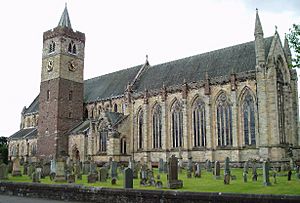Dúghall of Lorne facts for kids
Quick facts for kids Dúghall of Lorne |
|
|---|---|
| Bishop of Dunblane | |
| Church | Roman Catholic Church |
| See | Diocese of Dunblane |
| In Office | 1380–1403 |
| Predecessor | Andrew Magnus |
| Successor | Fionnlagh MacCailein |
| Orders | |
| Consecration | 12 September 1380 × 13 February 1381 |
| Personal details | |
| Born | unknown Lorne (?) |
| Died | 1403 |
Dúghall of Lorne (died 1403) was an important church leader in Scotland during the late 1300s and early 1400s. He was likely a member of the MacDougall family from a place called Lorne in Argyll. Before becoming a bishop, he studied at the University of Oxford in England. When he returned to Scotland, he worked in the church and for the government. He held several church positions in different areas like Argyll, Dunkeld, Dunblane, and St Andrews. He also worked as a secretary and chaplain for Robert Stewart, Earl of Fife, who later became the Duke of Albany. Dúghall then became the Bishop of Dunblane and held this important role until he passed away in 1403.
Contents
Who Was Dúghall of Lorne?
His Family and Early Life
Dúghall came from the area of Argyll in Scotland. His last name is sometimes written as de Lorne or de Ergadia. These names were used by important members of the MacDougall family. He was related to John Gallda MacDougall, who was a powerful leader in Argyll. Some old books mistakenly said he was the son of Sir John Drummond. This would have made him the brother of Anabella Drummond, who was married to King Robert III of Scotland. However, this was not correct.
Studying at Oxford University
In 1364, Dúghall received special permission to travel to England and study at the University of Oxford. He stayed there for about two years. Later, in 1380, it was noted that he had studied for three years. He focused on two types of law: canon law (church law) and Roman law (ancient Roman legal rules).
Early Church Roles
After his studies, Dúghall began his career in the church. By 1371, he was in charge of the parish church of Kilmore. This church was supported by John Gallda, his relative. Dúghall held this position without having to do the daily duties of a priest. This meant he could receive money from the church without living there.
Later, Kilmore became a "prebend" of Lismore Cathedral. A prebend is like a special income given to a church official. By 1380, Dúghall was a "canon" (a type of priest) and held a prebend in the diocese of Argyll. He also held similar positions in the dioceses of Dunkeld and Dunblane. By 1380, he had even more church roles in the diocese of St Andrews.
Working for a Prince
Around 1380, Dúghall became the personal secretary and chaplain to Robert Stewart, Earl of Fife. Robert Stewart was the son of King Robert II of Scotland and later became the powerful Duke of Albany. Dúghall helped the Earl of Fife with his official letters and religious duties. In June 1380, Dúghall traveled to Avignon, France, where the Pope lived at the time. He presented a list of requests to the Pope on behalf of the Earl of Fife.
Bishop of Dunblane

Becoming a Bishop
While he was in Avignon, Dúghall was chosen to become the Bishop of Dunblane. This happened on September 12, 1380, by Pope Clement VII. He was officially made a bishop (called "consecration") by February 13, 1381. Soon after, he returned to Scotland. By this date, he was already back in Scotland, signing important documents for David Stewart, Earl of Strathearn, who was the brother of the Earl of Fife.
Life as Bishop
There isn't a lot of detailed information about Dúghall's time as Bishop of Dunblane. We know he was present at important events. For example, in 1392, he signed two official papers for Euphemia I, Countess of Ross in Stirling. Stirling was a royal town near the Dunblane diocese.
In 1394, the Pope made a decision about a church leader in Dunblane. The Pope said that Dúghall's choice for the "Dean" (another church official) of Dunblane was not valid. This was because the Pope had already reserved the right to choose that person.
In 1396, Bishop Dúghall traveled to Avignon again. He presented a list of requests to Pope Benedict XIII for many Scottish people and some Europeans. The Pope approved these requests.
His Final Years
The last time Bishop Dúghall is mentioned in records is in a document from a Scottish lord. In this document, Dúghall appears with the Duke of Albany and Walter Trail, who was the Archbishop of St Andrews. This document was written between 1398 and 1401.
We don't know the exact date Dúghall died, but it was before September 10, 1403. On that date, Fionnlagh MacCailein was chosen as the new Bishop of Dunblane. This means Dúghall likely passed away shortly before then. There are some hints that Bishop Dúghall might have added more canons (priests) to Dunblane Cathedral, but this is not completely certain.
Images for kids


